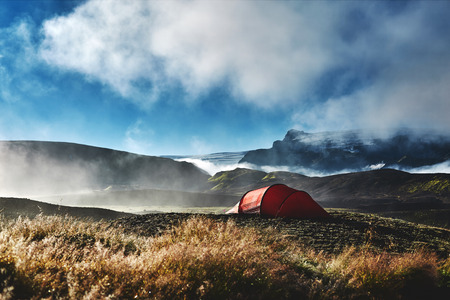Introduction to Tent Ventilation
When it comes to camping in America, from the humid forests of the Pacific Northwest to the dry deserts of the Southwest, understanding tent ventilation is key for a successful outdoor adventure. Proper ventilation is not just about comfort—it’s essential for safety and health, too. A well-ventilated tent helps regulate temperature, reduces stuffiness, and most importantly, prevents condensation build-up inside your shelter. Without adequate airflow, moisture from your breath and the environment can collect on the tent walls, making sleeping bags damp and creating an uncomfortable sleeping environment. In America’s varied climates, knowing how to manage airflow in your tent means you’ll wake up refreshed and ready for another day of exploring nature with your family.
2. How Condensation Forms Inside Tents
Condensation inside tents is a common challenge, especially for families new to camping. Understanding the science behind condensation can help you take practical steps to keep your tent dry and comfortable. Simply put, condensation happens when warm, moist air comes into contact with a cooler surface—like the inside of your tent walls. As temperatures drop at night, the air inside your tent cools down and loses its ability to hold moisture, causing water vapor to turn into liquid droplets on surfaces.
The main sources of moisture inside a tent are body heat, breathing, wet clothing, and even cooking. Since our bodies release heat and humidity throughout the night, especially when multiple family members are sleeping together in one tent, this naturally increases the risk of condensation. Weather also plays a big role: high humidity levels and rainy conditions mean more moisture in the air, which can quickly build up inside a closed tent.
Here’s a simple table to illustrate how different factors contribute to condensation:
| Factor | Description | Impact on Condensation |
|---|---|---|
| Body Heat & Breathing | Humans exhale warm, moist air while sleeping. | Increases humidity inside the tent. |
| Weather Conditions | Rain or high outdoor humidity adds extra moisture. | Makes it harder for air to stay dry inside the tent. |
| Wet Gear or Clothes | Damp items release additional moisture as they dry out overnight. | Adds to overall humidity and speeds up condensation. |
| Poor Ventilation | Lack of airflow traps humid air inside. | Prevents moisture from escaping, leading to more condensation. |
Being aware of these causes helps you plan ahead. For example, if you expect cold nights or rainy weather, you’ll know that extra precautions are necessary to reduce condensation and keep your family’s camping experience cozy and enjoyable.

3. Ventilation Features in Modern Tents
When it comes to camping with your family in the great outdoors, American tent brands have designed some clever ways to keep you comfortable and dry inside your tent. Modern tents often come equipped with various ventilation features to help reduce condensation and encourage airflow. One of the most common options you’ll find is mesh panels—these are lightweight sections built into the doors, ceilings, or sidewalls of the tent. Mesh panels let fresh air circulate while keeping bugs out, making them especially popular for summer camping trips.
Windows are another key feature in many tents from well-known U.S. outdoor brands. These windows can often be zipped open or closed depending on the weather, allowing campers to adjust ventilation as needed. Some windows even have storm flaps for extra protection during rainy nights, so you can enjoy a breeze without worrying about getting wet.
Vents—either roof vents, ground vents, or both—are also standard in modern family tents. Roof vents allow warm, moist air to escape upwards, which helps prevent that clammy feeling in the morning. Ground vents near the base of the tent promote low-level airflow, drawing in cooler air and pushing warm air out through the top.
Together, these features work to balance comfort and practicality, helping families enjoy their camping adventure without waking up to wet sleeping bags or stuffy air. When shopping for your next tent, look for these practical ventilation options—they make a big difference on those cozy nights under the stars.
4. Tips for Preventing Condensation
Condensation inside your tent can put a damper on any family camping adventure, but with some practical planning and know-how, it’s easy to keep everyone comfortable and dry. Here are some tried-and-true tips for American families and campers to prevent condensation in your tent:
Choose the Right Campsite
Picking the right spot to pitch your tent is the first step in minimizing moisture buildup. Avoid low-lying areas where cold air and moisture tend to settle overnight. Instead, look for elevated ground with natural drainage. If possible, set up under light tree cover, which can help reduce temperature swings and dew formation.
Manage Airflow Effectively
Proper airflow is key to reducing condensation. Most modern tents come with built-in vents—make sure you open them fully, even when it’s chilly outside. Position your tent so doors or windows face into any breeze, allowing fresh air to circulate. If weather permits, leave rain flies partially open for even better ventilation.
Tent Setup Best Practices
A few simple adjustments during setup can make a big difference. Try to avoid bringing wet gear or clothing into the tent. Store shoes and wet items in a vestibule or outside under a tarp. If you’re camping with kids, remind them to shake off dew from sleeping bags and jackets before coming inside.
Quick Reference Table: Tent Condensation Prevention Tips
| Tip | Why It Works | Family-Friendly Advice |
|---|---|---|
| Pick high ground | Keeps cold air and moisture away | Let kids help find the perfect spot! |
| Open all vents | Promotes airflow and reduces humidity | Teach children about zippers and vent flaps as part of setup |
| Store wet gear outside | Reduces extra moisture inside tent | Create a “mud room” area with a tarp for shoes and raincoats |
| Use double-wall tents if possible | Adds an extra barrier against condensation | Discuss the benefits of different tent designs as a learning opportunity |
| Avoid overcrowding the tent | Less body heat means less moisture buildup | If camping with friends, consider two tents instead of one large one |
By following these simple yet effective steps, your family can focus on making memories—not dealing with damp sleeping bags! Remember, the best camping trips are dry, cozy, and full of laughter.
5. Managing Moisture During All Seasons
Keeping your tent dry requires different strategies depending on the time of year and the unique climate you’re camping in. Whether you’re setting up camp during humid summers on the East Coast or braving chilly nights in the mountains out West, understanding season-specific moisture management is key to a comfortable adventure.
Summer Camping: Humid Climates
During hot and sticky East Coast summers, condensation can build up quickly inside your tent due to high humidity levels. To minimize moisture:
- Maximize airflow: Open all available vents and windows, even if you’re using the rainfly, to let air circulate.
- Choose a breezy spot: Pitch your tent where it will catch natural breezes, such as near water or open fields—just be mindful of flood risks.
- Use mesh panels: Take advantage of tents with large mesh areas to promote ventilation while keeping bugs out.
Fall and Spring: Dealing With Changing Weather
Transitional seasons can bring unpredictable rain and shifting temperatures. Here’s how to stay dry:
- Ventilate even when it rains: Keep at least one vent or window slightly open under the rainfly to release moist air without letting water in.
- Avoid cooking inside the tent: Steam from cooking adds unwanted humidity—set up an outdoor kitchen area instead.
- Dry gear outside: Leave wet clothes and shoes outside the tent overnight, under a vestibule or tarp if necessary.
Winter and Mountain Camping: Cold Weather Tips
Chilly mountain nights or winter trips present their own challenges, as warm breath meets cold tent walls, creating condensation. Try these tips:
- Slightly open vents—even in the cold: It might seem counterintuitive, but a bit of ventilation prevents excess moisture from collecting inside.
- Keep gear organized: Store damp items away from sleeping areas and hang them up if possible.
- Use a groundsheet properly: Tuck it fully under your tent so rain or melting snow doesn’t collect between layers.
Universal Pro Tips for All Seasons
- Wipe down tent walls in the morning: Use a small camp towel to mop up any condensation that formed overnight.
- Pace yourself with drying breaks: On multi-day trips, allow time each day to air out your tent when conditions permit.
- Packing up? If your tent is damp, pack it loosely and dry it thoroughly at home before storage to prevent mildew.
Remember: Every season brings its own moisture challenges, but with thoughtful planning and small adjustments, you can keep your family’s camping adventures dry and comfortable year-round!
6. Quick Fixes and Equipment Recommendations
For American families who love camping, dealing with condensation and ensuring proper tent ventilation doesn’t have to be a hassle. Here are some quick fixes and popular equipment choices that can make your next camping trip more comfortable and enjoyable:
Handy Products for Condensation Control
- Microfiber Camp Towels: These absorbent towels are perfect for wiping down tent walls in the morning. They dry quickly and pack small, making them a must-have for families.
- Battery-Powered Fans: A portable fan helps circulate air inside the tent, reducing moisture buildup overnight. Many models are lightweight and easy to hang from the ceiling of most family tents.
- Tent Dehumidifier Bags: Reusable silica gel packs or special dehumidifier bags are great for absorbing excess moisture, especially during rainy trips.
Easy Solutions for Better Ventilation
- Open Vents and Windows: Whenever possible, leave your tent’s vents or windows slightly open—even in cooler weather—to encourage airflow and let moist air escape.
- Set Up Under a Tarp: Pitching a tarp above your tent offers extra rain protection, allowing you to keep vents open without letting water in.
- Avoid Cooking Inside: Try to prepare meals outside the tent when possible. This prevents steam and cooking odors from adding extra humidity inside your sleeping area.
Family-Friendly Brands
Popular brands among American campers include REI Co-op, Coleman, and Therm-a-Rest. These companies offer reliable gear such as fans, absorbent towels, and high-quality tents designed with built-in ventilation features.
Final Tip
Packing these simple tools—and encouraging everyone in the family to help manage condensation—will keep your tent dry and cozy all night long. With just a few small changes, you can enjoy every camping adventure with greater comfort and peace of mind!

